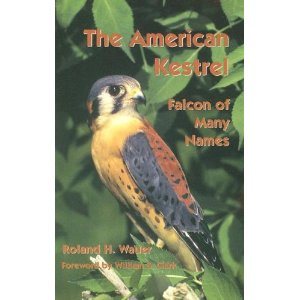
American Kestrel
(Falco sparvarius)
The American Kestrel is the smallest and most common falcon in North America. Unlike many other species of falcons, males and female kestrels have different plumages.
Adult Male American Kestrel
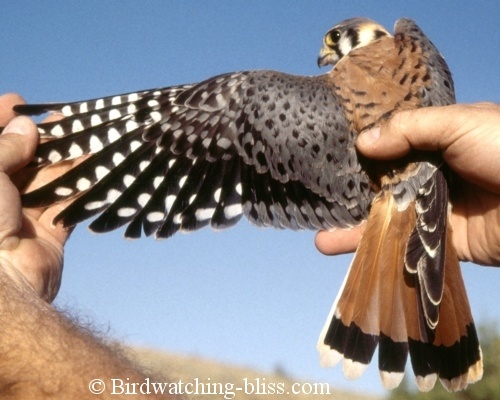
Males have blue/gray upper wings coverts and the wing tips are black with white spots. The back is rufous with bars. The lower back only is barred in adults (upper back clear), while the back is completely barred on juveniles. The tail color is variable, but most are reddish, with a wide sub-terminal black band. The tips of the tail is white.
Females have barred reddish brown backs and upper wings coverts. The wing tips are brownish without white spots. Tails are reddish brown with brown bands. Juvenile females are similar to adults.
As noted in the Falcon photos page, American Kestrels are reverse size dimorphic, meaning that the females are larger than the males. The dimorphism is not nearly as pronounced for Kestrels as it is for some other falcons and Accipiters, so there is more overlap in size (weight and wing measurements) between male and female American Kestrels.
Data below from
A Photographic Guide to North American Raptors![]() ,
Wheeler & Clark 1995 - We highly recommend this book for anyone interested in raptors. Wheeler & Clark did not separate Male and Female data:
,
Wheeler & Clark 1995 - We highly recommend this book for anyone interested in raptors. Wheeler & Clark did not separate Male and Female data:
- Length: 8-10 inches (22-27 cm)
- Wingspan: 20-24 inches (52-61 cm)
- Weight: 97-150 grams (3.4-5.3 oz)
Some wing and weight data that we have collected are presented below for American Kestrels.
American Kestrel un-flattened Wing Chord*:
- Males: mean 185.0 mm (171-196; n = 64)
- Females: mean 194.5 mm (180-210; n = 39)
American Kestrel Weight (No Food in Crop)**:
- Males: mean 110.2 g (88-130; n = 59)
- Females: mean 127.2 g (106-155; n = 40)
*Wing Chord is measured from from the wrist to the tip of the longest primary feather. The primary feathers have a natural camber (bend), and can be measured flattened or un-flattened.
**Raptors store food in a crop (pouch in the throat area). Food in the crop or stomach can effect the birds weight. We cannot know if there is food in the stomach, but we can estimate the amount of food in the crop. We score the crop on a 0 = no food in the crop to a 3 = full crop.
Nice Closeup Video of an American Kestrel through Digiscoping:
Kestrels nest in cavities (cracks and crevices on cliffs or banks and holes in trees). They do not make their own cavities, but depend upon other birds (such as flickers or kingfishers) or natural processes for their nesting cavities. But you could help by building a Kestrel Nest Box: American Kestrel Nest Box Plans
American Kestrels are partially migratory. Some migrate South into Central America, while others spend the Winter in some very cold areas in the Northern U.S. and Southern Canada.
Kestrels can be seen on migration at some very well known Raptor migration sites such as Hawk Mountain (Pa), Cape May Point (NJ) and many other sites. They are among the first raptors to begin migration.
Longevity Record: 14 Years and 8 months; based upon an adult male American Kestrel captured in Utah in 1987 that was found dead in 2001 - data from USGS Bird Banding Lab (Klimkiewicz 2008)
Listen to the Call of an American Kestrel
References for American Kestrel information:
Bent, A.C. 1937. Life Histories of North American birds of prey. U.S. National Museum Bulletin. 167:106-121. Wash. D.C.
Call. M.W. 1978. Nesting Habitats and Surveying Techniques for Common Western Raptors. Tech. Note TN-316. Bureau of Land Management. Denver Service Center.
Clark, W.S. and B.K. Wheeler. 1987. A Field Guide to Hawks of North America. The Peterson Field Guide Series. Houghton Mifflin. Boston.
Ehrlich, P.R., D.S. Dobkin and D. Wheye. 1988. The Birder's Handbook. A Field Guide to the Natural History of North American Birds. Simon and Schuster. New York.
Klimkiewicz, M. K. 2008. Longevity Records of North American Birds. Version 2008.1. Patuxent Wildlife Research Center. Bird Banding Laboratory. Laurel MD.
Related Bird of Prey Pages:
Go to Raptor Migration - Learn where you can see 1000s of Kestrels during Fall Migration.
Go to Hawk Photos page (Buteos)
American Kestrel Nest Box Placement
American Kestrel Bird Identification
Go to Bird Watching Bliss Home
|
Our Favorite Bird Watching Binoculars, Squirrel-Proof Feeder & Hummingbird Feeder Read Our Reviews: |
||
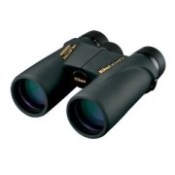
Nikon Monarch M5
Best mid-priced bird watching binoculars. Waterproof, shockproof, multi-coated ED-Glass. |
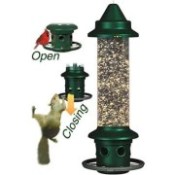
|
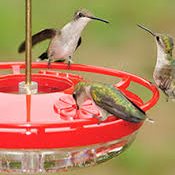
Best Hummingbird Feeder
Drip-Free, Ant-moat, Durable, Easy to Fill and Clean. |
| Click Images or Links To View More Info | ||
